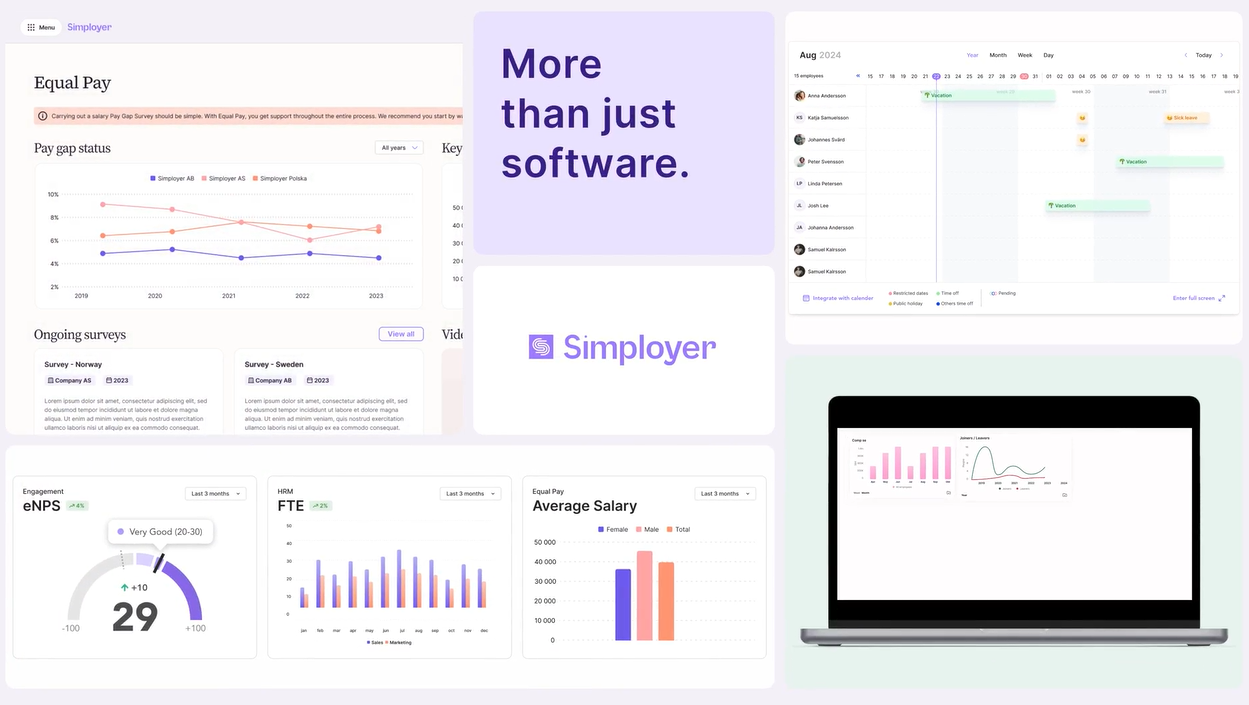An HR system is not just about technology, but about solving real challenges in everyday work. When you recognize the problems – and know which features a modern system should have – it becomes much easier to choose the right solution.

What is an HR system?
Everything you need to know!
What is an HR-system, HRM, HCM, HR-platform?
No matter what you call it, the goal is always the same. The system should make everyday work easier. It should streamline processes, create structure and enable consistent leadership. And most importantly. It should give you as an HR leader the freedom to spend more time with your people, and less on administration.
For us, HR is never just about systems. It is about people. A good HR system is the engine of your organization. It keeps track of everything from contracts to vacation plans and provides both managers and employees with clarity and confidence. But we also know that not every system delivers on that promise.
An HR system should bring everything together in one place. Onboarding should be just as clear as offboarding. Absence and working hours should be easy to manage. Pay and compensation data should be accurate and safely stored. And you should not have to worry about laws and regulations, because the system keeps you updated. When all of this works, you free up time for what matters most. Your people.

Before you evaluate vendors, it is important to ask the simple question: Which challenges should our HR system actually solve? Many organizations recognize themselves in these five pitfalls:
-
Low employee engagement
-
High turnover and frequent replacements
-
Too much administration
-
High absence due to sickness
-
Weak communication between managers and employees
Et nytt system alene løser ikke alt. Men det kan være nøkkelen til å frigjøre tid, gi bedre oversikt og gjøre HR mer strategisk.
A new system alone does not solve everything. But it can be the key to freeing up time, providing better overview, and making HR more strategic.

What should a modern HR system include?
A modern HR system is more than an archive. It should be easy to use, with clear processes and built-in guidance directly in the system. User-friendliness means that both managers and employees can complete tasks correctly the first time.
And it should bring everything together in one place: employee data, onboarding, absence, time, compensation, health and safety, and reporting. When everything is in the same solution, everyday work becomes simpler and more secure.
What should you consider when choosing an HR solution
User-friendliness in practice
An HR system should be simple enough that both managers and employees actually use it. When tasks can be done correctly the first time without manuals, the system creates real value in everyday work.
Read more about how to optimize efficiency and HR processes
Integrations and flexibility
An HR system should connect with payroll, finance, recruitment and tools like Teams or Slack. When data flows freely, you avoid duplicate work and get insights where you need them.
Stay on top of laws and regulations
HR is also about laws, regulations and security. Choose a provider that understands Nordic working life, keeps you updated on GDPR, and offers support in your language whenever you need it.

Nina Hopland Brattaule
CEO | Eager"For small and mid-sized companies that often struggle with inefficient Excel processes, this is a real change – a scalable solution that ensures compliance and a great employee experience."

Anniken Overgaard
HR manager | PMD"The biggest difference is that we can now work proactively and create value instead of constantly putting out fires. We have control of our data, which allows us to focus on strategic HR initiatives that move PMG forward instead of chasing numbers."

Jakob Lunøe
CEO | Delogue PLM"For me it is crucial to support decisions about strategy and leadership with facts, not just gut feeling. Companies like ours are worth millions less if we cannot control and document these things."
What do you achieve with the right HR system?
Less administration
Automate manual tasks and remove duplicate work. When tasks are handled in a single interface, HR frees up time for strategy, culture and people – instead of data entry and reporting.Faster decisions
Give managers up-to-date insights and clear processes in real time. With alerts, overviews and suggestions at hand, decisions become more intuitive, faster and more secure.Better employee experience
Create a smooth employee journey from day one. Onboarding feels structured and welcoming, while absence and vacation are managed in just a few clicks. The result is higher engagement, trust and loyalty.
Choosing an HR system (HRM system / HR software) is as much about processes and change as it is about features. Avoid these pitfalls:
-
Underestimating integrations. Check data flow with payroll, ERP, SSO/AD, recruitment, and time tracking.
-
Not involving users. Management and line managers need to be part of the process – adoption determines the outcome.
-
Ignoring the Nordic context. Choose a solution with local GDPR compliance, labour law alignment, and language support.
-
Choosing a solution that’s too simple. Many “lightweight” tools only work for a while. An HR system should be flexible and scalable so it grows with your organisation.
-
Focusing only on price. Consider the total cost of ownership (licence, implementation, time saved, maintenance).
When is it time to change your HR system?
From spreadsheets to a modern HR solution
Excel and SharePoint work for a while, but quickly become unmanageable as your organisation grows. Version chaos, manual processes and a lack of insights make it difficult to run efficient HR and maintain compliance.
-
Poor visibility of documents and routines → high risk
-
Time-consuming processes (absence, onboarding/offboarding)
-
Limited insights for managers
When your current HR system falls short
An HR system that feels heavy, outdated or not adapted to Nordic requirements often creates more frustration than value. Missing integrations, poor user experience and limited local support slow down both HR and managers.
-
Limited integrations → data flow stops
-
Little Nordic adaptation (GDPR, labour law, language)
-
Cost/benefit imbalance: high licence fees, low return
Why choose an HR system from Simployer?
At Simployer, you get more than just an HR system – you get a partner that combines technology and expertise in one solution. With over 40 years of experience and more than 12,000 customers, we know what creates real value in everyday HR. Our solution is built in the Nordics, grounded in local labour laws and GDPR, and continuously developed by more than 100 dedicated developers. In total, we’re 300 employees passionate about making HR simpler and better – for managers, employees, and organisations alike.
-1.gif?width=1280&height=718&name=GIF%20Take%20a%20quick%20tour%20with%20Simployer%20(6)-1.gif)
Simployer’s HR system makes it easy to automate processes, gain better insights, and ensure compliance with GDPR and local regulations – all in one platform. The result: less administration, stronger decision-making, and more time for strategic HR.
Your trusted HR partner in the Nordics
40 years of experience
Founded in 1985 in Norway
1.2 million users
Across på 12,000 customers
300 employees
6 offices in 3 countries
We're all about making HR simpler. And better. For you. For the managers. For the employees.
The terms are often used interchangeably. HRM (Human Resource Management) and HCM (Human Capital Management) describe broader processes, but in practice, they all refer to the same thing – consolidating employee processes into a single system.
A modern HR system should be more than a place to store employee information. It should provide a flexible foundation that grows with your organisation and make it easy to manage everything from onboarding to compliance in one place.
The right system integrates seamlessly with the tools you already use, ensuring that data flows automatically and securely across your processes. This makes HR work efficient, connected, and adaptable as your organisation evolves.
Above all, the system should be built on insights from real HR challenges – not just a list of features, but a tool that truly helps you work smarter, faster, and with confidence.
Explore our overview
The cost of an HR system should reflect your organisation’s needs and budget, without compromising on quality. Many enterprise solutions have complex pricing models, hidden costs, and require dedicated resources to manage.
At the other end of the spectrum, “lightweight” tools offer low prices but often lack the flexibility and depth HR teams need, forcing you to patch with other solutions.
A well-designed HR system combines the strength and flexibility of a robust platform with transparency, scalability, and ease of administration – delivering real value without surprises.
Learn more about pricing at Simployer
A modern HR system should do more than store employee data – it should actively help the organisation work in a GDPR-compliant way. This means sensitive information is handled securely, stored in a structured and traceable way, and only accessible to those who need it.
Behind the scenes, the best systems use advanced security measures – from encryption to strict access controls – and rely on trusted technology partners.
This combination of compliance-by-design and robust security ensures that employee data is always handled in accordance with the law – today and in the future.
Read more at the Simployer trust center
Simployer is more than just software. We combine over 40 years of HR and legal expertise with AI innovation, built-in compliance, and direct access to experts. The result is not just a system, but ready-made, compliant processes that free HR from firefighting to strategy – empowering leaders to drive culture, talent, and growth.
Our platform is designed for organisations that want to simplify HR without compromising on compliance or flexibility. Whether you’re a growing business building more structured HR processes, or an established company looking for a more strategic, integrated solution, you’ll find a platform that adapts as your needs evolve.
Getting started with a new HR system shouldn’t feel overwhelming. That’s why our implementation process is structured, guided, and built on close collaboration. From day one, you’ll have a dedicated implementation team working with you to understand your needs, configure the platform, and ensure secure and accurate data migration.
Throughout the process, you’ll have clear milestones and transparent communication, so your team feels confident at every step. The result is a smooth, structured rollout that helps you realise value quickly – without unnecessary stress or disruption to your daily operations.